Analyzing Drought's Influence on Australian Macroeconomic Equilibrium
VerifiedAdded on 2023/04/24
|7
|1207
|63
Essay
AI Summary
This essay delves into the prospective effects of drought on the macroeconomic equilibrium of Australia. It begins by defining drought and its influence on supply-side variables, particularly agriculture, energy, and related sectors. The essay analyzes macroeconomic equilibrium using aggregate demand and supply curves, illustrating how drought acts as a negative supply shock, leading to decreased output, inflation, and shifts in the equilibrium. The analysis includes diagrams depicting these shifts and discusses historical droughts in Australia, providing evidence of their impacts on GDP, agricultural production, and the balance of payments. The essay also examines government intervention, such as financial assistance to farmers and fiscal policy adjustments, and how these measures can modify the macroeconomic impact of drought. The conclusion reiterates the adverse effects of drought and emphasizes the importance of effective government policies in mitigating its severity and restoring economic stability.
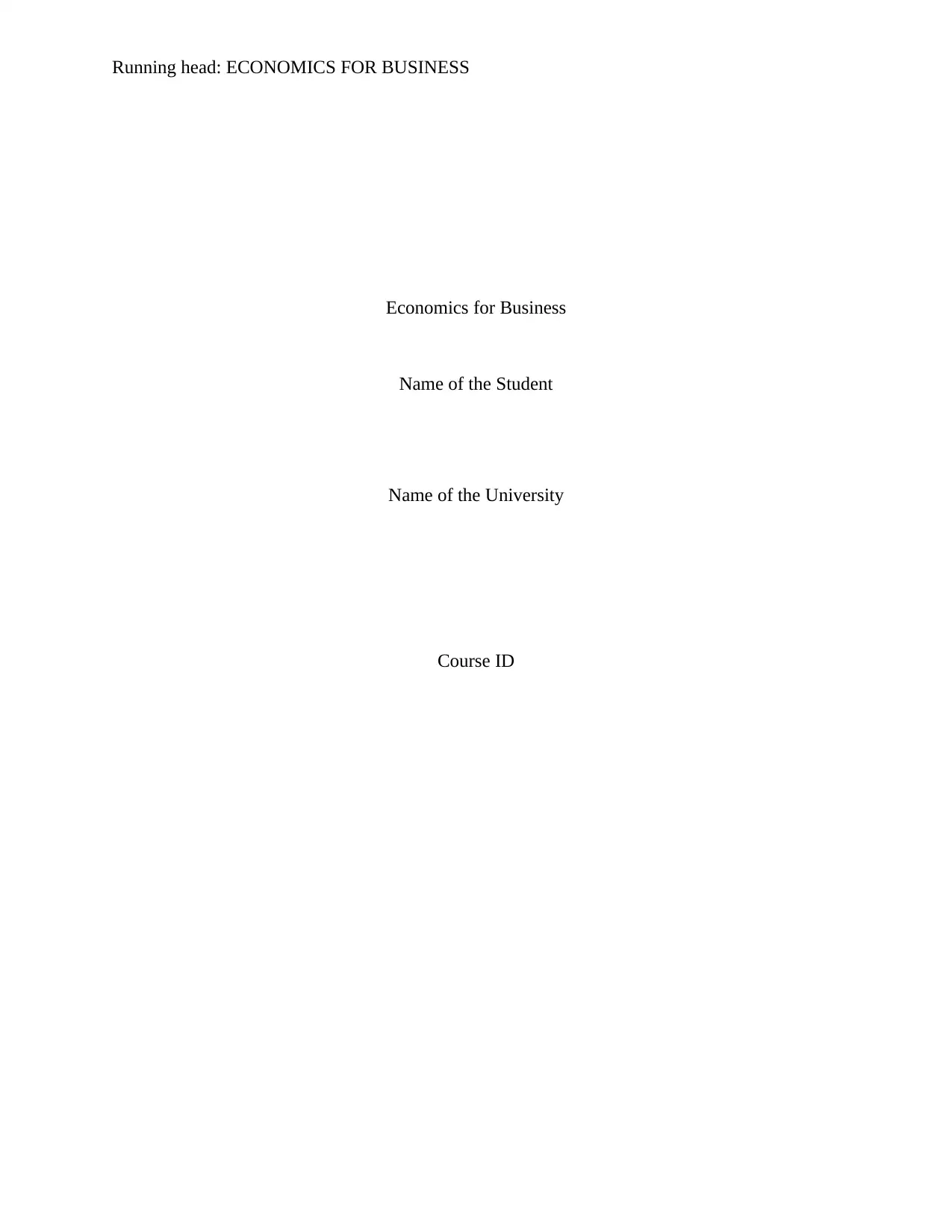
Running head: ECONOMICS FOR BUSINESS
Economics for Business
Name of the Student
Name of the University
Course ID
Economics for Business
Name of the Student
Name of the University
Course ID
Paraphrase This Document
Need a fresh take? Get an instant paraphrase of this document with our AI Paraphraser
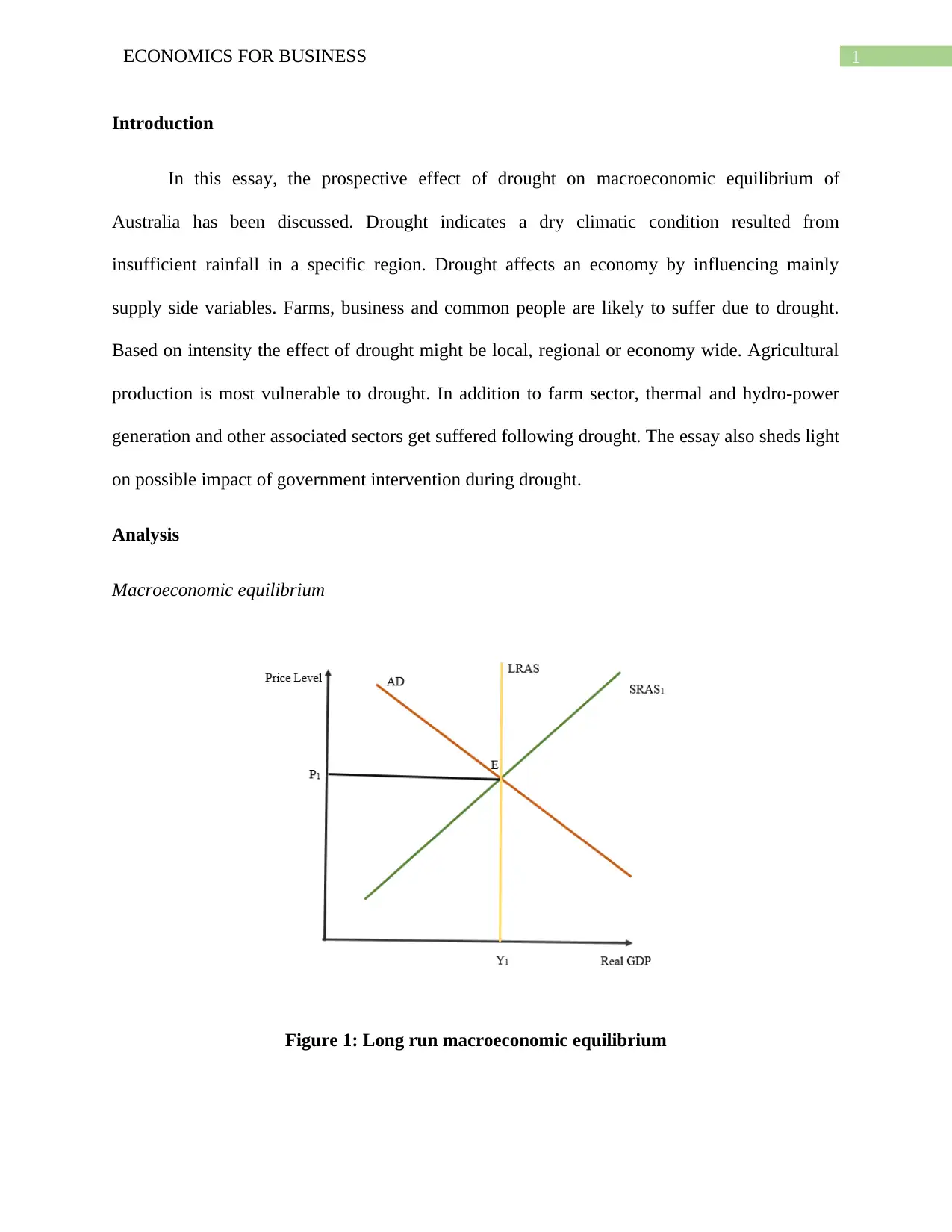
1ECONOMICS FOR BUSINESS
Introduction
In this essay, the prospective effect of drought on macroeconomic equilibrium of
Australia has been discussed. Drought indicates a dry climatic condition resulted from
insufficient rainfall in a specific region. Drought affects an economy by influencing mainly
supply side variables. Farms, business and common people are likely to suffer due to drought.
Based on intensity the effect of drought might be local, regional or economy wide. Agricultural
production is most vulnerable to drought. In addition to farm sector, thermal and hydro-power
generation and other associated sectors get suffered following drought. The essay also sheds light
on possible impact of government intervention during drought.
Analysis
Macroeconomic equilibrium
Figure 1: Long run macroeconomic equilibrium
Introduction
In this essay, the prospective effect of drought on macroeconomic equilibrium of
Australia has been discussed. Drought indicates a dry climatic condition resulted from
insufficient rainfall in a specific region. Drought affects an economy by influencing mainly
supply side variables. Farms, business and common people are likely to suffer due to drought.
Based on intensity the effect of drought might be local, regional or economy wide. Agricultural
production is most vulnerable to drought. In addition to farm sector, thermal and hydro-power
generation and other associated sectors get suffered following drought. The essay also sheds light
on possible impact of government intervention during drought.
Analysis
Macroeconomic equilibrium
Figure 1: Long run macroeconomic equilibrium
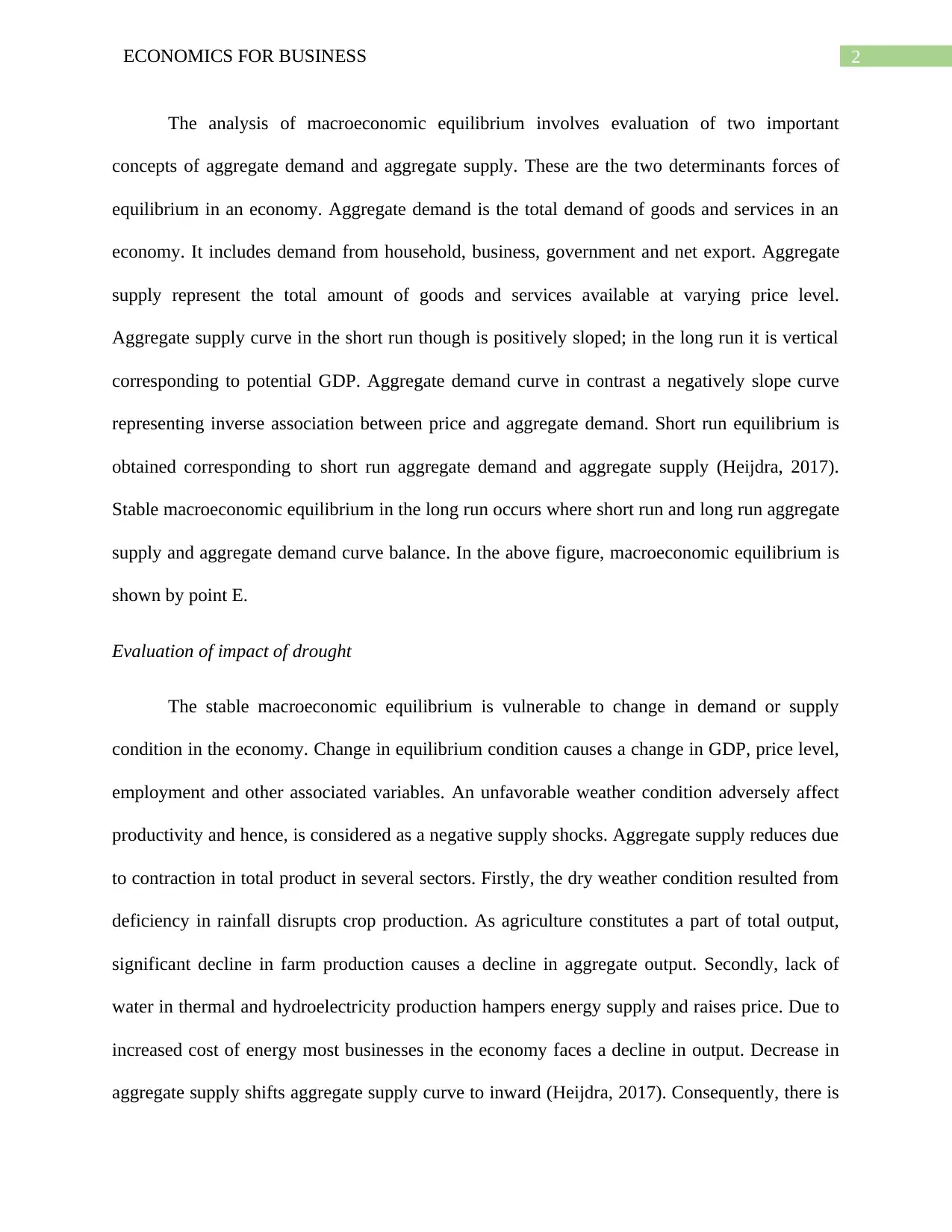
2ECONOMICS FOR BUSINESS
The analysis of macroeconomic equilibrium involves evaluation of two important
concepts of aggregate demand and aggregate supply. These are the two determinants forces of
equilibrium in an economy. Aggregate demand is the total demand of goods and services in an
economy. It includes demand from household, business, government and net export. Aggregate
supply represent the total amount of goods and services available at varying price level.
Aggregate supply curve in the short run though is positively sloped; in the long run it is vertical
corresponding to potential GDP. Aggregate demand curve in contrast a negatively slope curve
representing inverse association between price and aggregate demand. Short run equilibrium is
obtained corresponding to short run aggregate demand and aggregate supply (Heijdra, 2017).
Stable macroeconomic equilibrium in the long run occurs where short run and long run aggregate
supply and aggregate demand curve balance. In the above figure, macroeconomic equilibrium is
shown by point E.
Evaluation of impact of drought
The stable macroeconomic equilibrium is vulnerable to change in demand or supply
condition in the economy. Change in equilibrium condition causes a change in GDP, price level,
employment and other associated variables. An unfavorable weather condition adversely affect
productivity and hence, is considered as a negative supply shocks. Aggregate supply reduces due
to contraction in total product in several sectors. Firstly, the dry weather condition resulted from
deficiency in rainfall disrupts crop production. As agriculture constitutes a part of total output,
significant decline in farm production causes a decline in aggregate output. Secondly, lack of
water in thermal and hydroelectricity production hampers energy supply and raises price. Due to
increased cost of energy most businesses in the economy faces a decline in output. Decrease in
aggregate supply shifts aggregate supply curve to inward (Heijdra, 2017). Consequently, there is
The analysis of macroeconomic equilibrium involves evaluation of two important
concepts of aggregate demand and aggregate supply. These are the two determinants forces of
equilibrium in an economy. Aggregate demand is the total demand of goods and services in an
economy. It includes demand from household, business, government and net export. Aggregate
supply represent the total amount of goods and services available at varying price level.
Aggregate supply curve in the short run though is positively sloped; in the long run it is vertical
corresponding to potential GDP. Aggregate demand curve in contrast a negatively slope curve
representing inverse association between price and aggregate demand. Short run equilibrium is
obtained corresponding to short run aggregate demand and aggregate supply (Heijdra, 2017).
Stable macroeconomic equilibrium in the long run occurs where short run and long run aggregate
supply and aggregate demand curve balance. In the above figure, macroeconomic equilibrium is
shown by point E.
Evaluation of impact of drought
The stable macroeconomic equilibrium is vulnerable to change in demand or supply
condition in the economy. Change in equilibrium condition causes a change in GDP, price level,
employment and other associated variables. An unfavorable weather condition adversely affect
productivity and hence, is considered as a negative supply shocks. Aggregate supply reduces due
to contraction in total product in several sectors. Firstly, the dry weather condition resulted from
deficiency in rainfall disrupts crop production. As agriculture constitutes a part of total output,
significant decline in farm production causes a decline in aggregate output. Secondly, lack of
water in thermal and hydroelectricity production hampers energy supply and raises price. Due to
increased cost of energy most businesses in the economy faces a decline in output. Decrease in
aggregate supply shifts aggregate supply curve to inward (Heijdra, 2017). Consequently, there is
⊘ This is a preview!⊘
Do you want full access?
Subscribe today to unlock all pages.

Trusted by 1+ million students worldwide
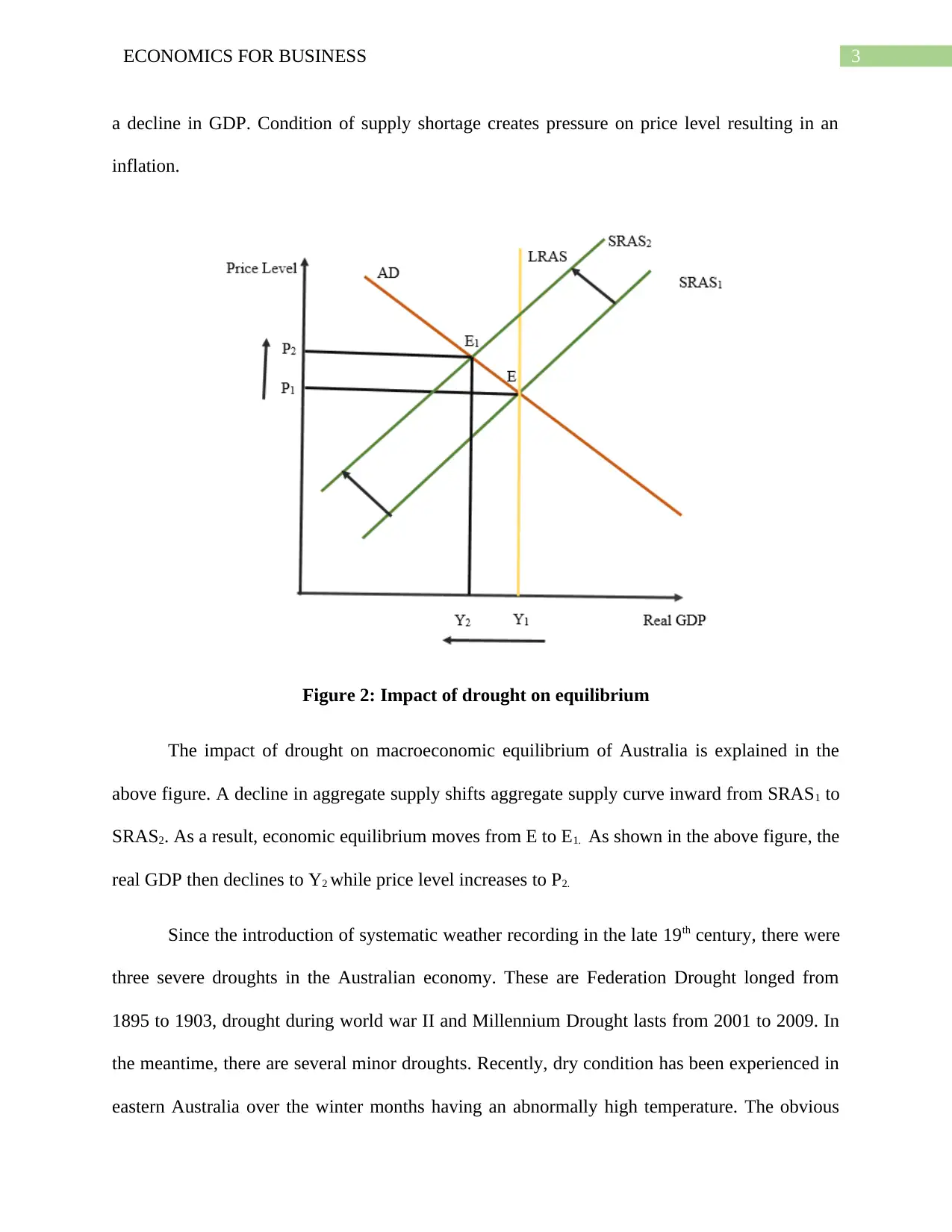
3ECONOMICS FOR BUSINESS
a decline in GDP. Condition of supply shortage creates pressure on price level resulting in an
inflation.
Figure 2: Impact of drought on equilibrium
The impact of drought on macroeconomic equilibrium of Australia is explained in the
above figure. A decline in aggregate supply shifts aggregate supply curve inward from SRAS1 to
SRAS2. As a result, economic equilibrium moves from E to E1. As shown in the above figure, the
real GDP then declines to Y2 while price level increases to P2.
Since the introduction of systematic weather recording in the late 19th century, there were
three severe droughts in the Australian economy. These are Federation Drought longed from
1895 to 1903, drought during world war II and Millennium Drought lasts from 2001 to 2009. In
the meantime, there are several minor droughts. Recently, dry condition has been experienced in
eastern Australia over the winter months having an abnormally high temperature. The obvious
a decline in GDP. Condition of supply shortage creates pressure on price level resulting in an
inflation.
Figure 2: Impact of drought on equilibrium
The impact of drought on macroeconomic equilibrium of Australia is explained in the
above figure. A decline in aggregate supply shifts aggregate supply curve inward from SRAS1 to
SRAS2. As a result, economic equilibrium moves from E to E1. As shown in the above figure, the
real GDP then declines to Y2 while price level increases to P2.
Since the introduction of systematic weather recording in the late 19th century, there were
three severe droughts in the Australian economy. These are Federation Drought longed from
1895 to 1903, drought during world war II and Millennium Drought lasts from 2001 to 2009. In
the meantime, there are several minor droughts. Recently, dry condition has been experienced in
eastern Australia over the winter months having an abnormally high temperature. The obvious
Paraphrase This Document
Need a fresh take? Get an instant paraphrase of this document with our AI Paraphraser

4ECONOMICS FOR BUSINESS
impact of drought in Australia was felt in terms of a huge decline in agricultural production. The
adverse effect of drought was also felt on live stocks. During drought, there was a recorded
decline in meat production. In the last fifty-year span, real gross farm product in Australia fell by
27.5 percent. There is a relatively small decline in farm output during recent drought as they
were more concentrated in regions. Drought has also affected the broader economy of Australia.
Agricultural output constitutes 12.5 percent of nation’s GDP. Drought occurred in the middle of
1960 reduced real GDP growth by 2.5 percent on an average. The drought of early 1980s,
decline in agricultural output reduced real GDP growth by less than 6 percent. Drought also
affected the balance of payment account by reducing rural export. Agriculture now accounts 10
percent of total export in Australia. Decline in farm’s output caused a contraction in
employment.
Government policy intervention
Government intervenes in an economy to correct economic shocks. Demand sided policy
can be taken to boost aggregate demand. An obvious way of government’s help is to give
financial and other assistance to the farmers and affected rural communities in times of severe
drought. The Federal Labor Government launched National Drought Policy in 1992 (abc.net.au.,
2018) Government through this policy introduced subsidized interest rate and program for
farmers’ family support.
The continuous assistance of government helps to reduce severity of drought. The
increasing probability of drought precautionary events during summer and spring implies that
drought conditions are likely to continue in eastern Australia meaning that impact of drought in
the economy now is relatively smaller compared to that in 2000s.
impact of drought in Australia was felt in terms of a huge decline in agricultural production. The
adverse effect of drought was also felt on live stocks. During drought, there was a recorded
decline in meat production. In the last fifty-year span, real gross farm product in Australia fell by
27.5 percent. There is a relatively small decline in farm output during recent drought as they
were more concentrated in regions. Drought has also affected the broader economy of Australia.
Agricultural output constitutes 12.5 percent of nation’s GDP. Drought occurred in the middle of
1960 reduced real GDP growth by 2.5 percent on an average. The drought of early 1980s,
decline in agricultural output reduced real GDP growth by less than 6 percent. Drought also
affected the balance of payment account by reducing rural export. Agriculture now accounts 10
percent of total export in Australia. Decline in farm’s output caused a contraction in
employment.
Government policy intervention
Government intervenes in an economy to correct economic shocks. Demand sided policy
can be taken to boost aggregate demand. An obvious way of government’s help is to give
financial and other assistance to the farmers and affected rural communities in times of severe
drought. The Federal Labor Government launched National Drought Policy in 1992 (abc.net.au.,
2018) Government through this policy introduced subsidized interest rate and program for
farmers’ family support.
The continuous assistance of government helps to reduce severity of drought. The
increasing probability of drought precautionary events during summer and spring implies that
drought conditions are likely to continue in eastern Australia meaning that impact of drought in
the economy now is relatively smaller compared to that in 2000s.
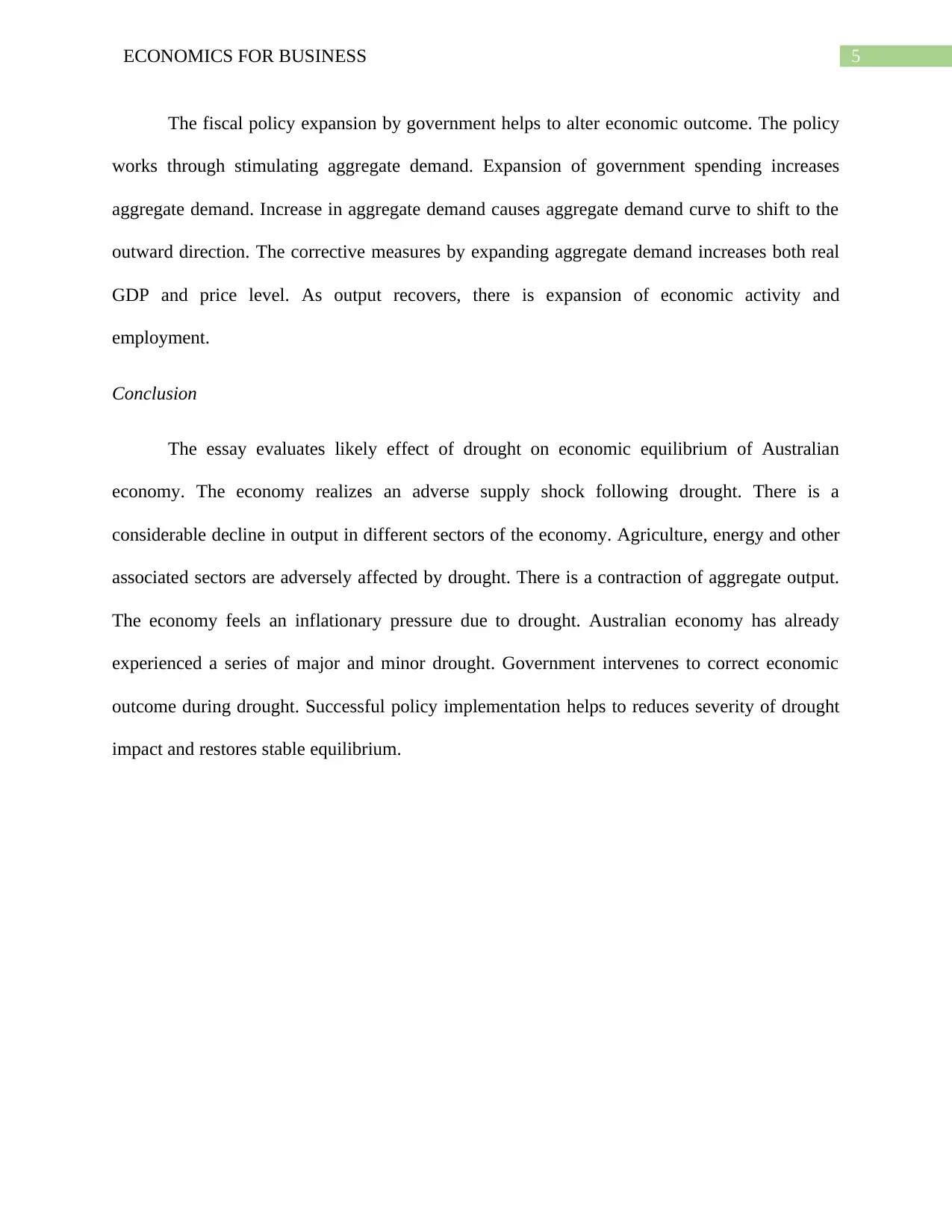
5ECONOMICS FOR BUSINESS
The fiscal policy expansion by government helps to alter economic outcome. The policy
works through stimulating aggregate demand. Expansion of government spending increases
aggregate demand. Increase in aggregate demand causes aggregate demand curve to shift to the
outward direction. The corrective measures by expanding aggregate demand increases both real
GDP and price level. As output recovers, there is expansion of economic activity and
employment.
Conclusion
The essay evaluates likely effect of drought on economic equilibrium of Australian
economy. The economy realizes an adverse supply shock following drought. There is a
considerable decline in output in different sectors of the economy. Agriculture, energy and other
associated sectors are adversely affected by drought. There is a contraction of aggregate output.
The economy feels an inflationary pressure due to drought. Australian economy has already
experienced a series of major and minor drought. Government intervenes to correct economic
outcome during drought. Successful policy implementation helps to reduces severity of drought
impact and restores stable equilibrium.
The fiscal policy expansion by government helps to alter economic outcome. The policy
works through stimulating aggregate demand. Expansion of government spending increases
aggregate demand. Increase in aggregate demand causes aggregate demand curve to shift to the
outward direction. The corrective measures by expanding aggregate demand increases both real
GDP and price level. As output recovers, there is expansion of economic activity and
employment.
Conclusion
The essay evaluates likely effect of drought on economic equilibrium of Australian
economy. The economy realizes an adverse supply shock following drought. There is a
considerable decline in output in different sectors of the economy. Agriculture, energy and other
associated sectors are adversely affected by drought. There is a contraction of aggregate output.
The economy feels an inflationary pressure due to drought. Australian economy has already
experienced a series of major and minor drought. Government intervenes to correct economic
outcome during drought. Successful policy implementation helps to reduces severity of drought
impact and restores stable equilibrium.
⊘ This is a preview!⊘
Do you want full access?
Subscribe today to unlock all pages.

Trusted by 1+ million students worldwide
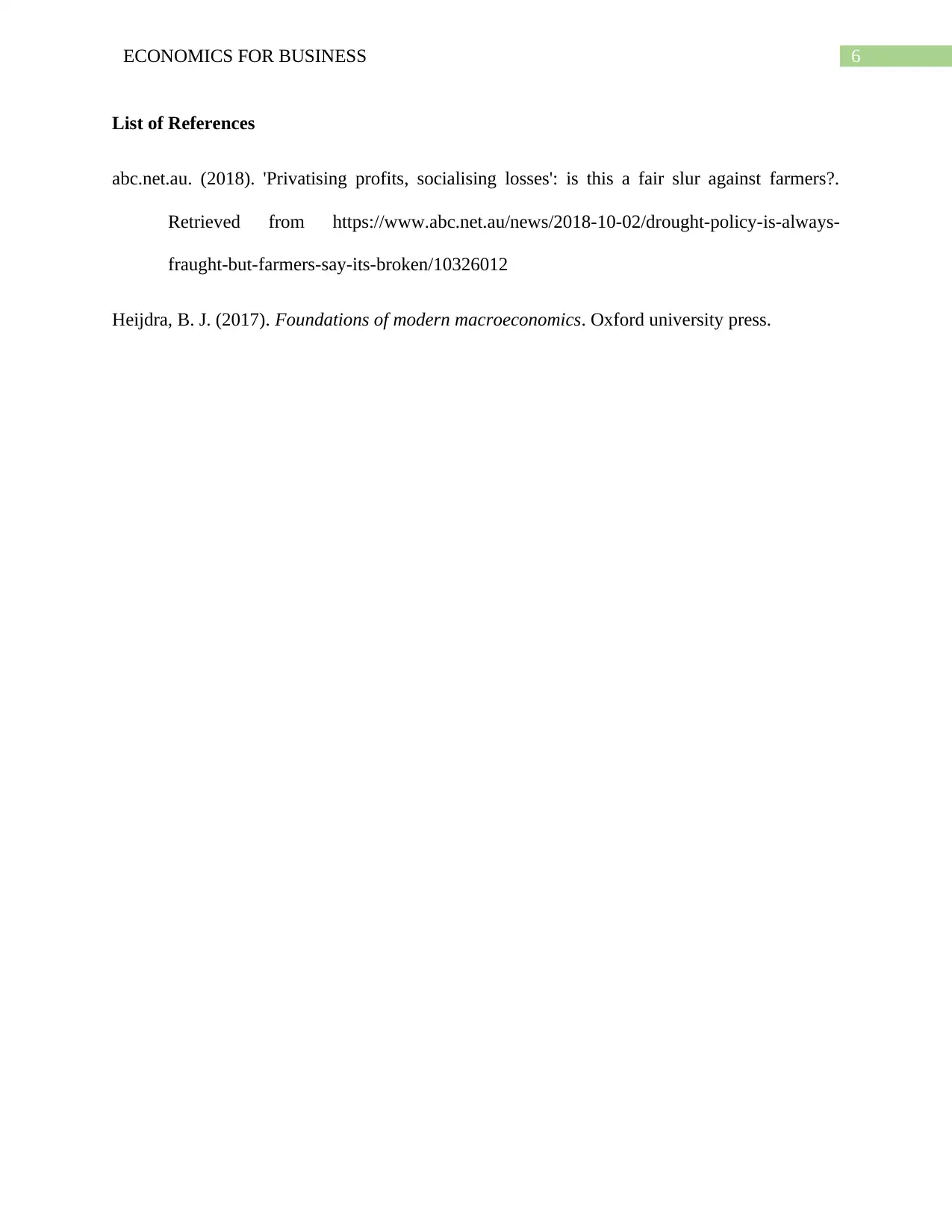
6ECONOMICS FOR BUSINESS
List of References
abc.net.au. (2018). 'Privatising profits, socialising losses': is this a fair slur against farmers?.
Retrieved from https://www.abc.net.au/news/2018-10-02/drought-policy-is-always-
fraught-but-farmers-say-its-broken/10326012
Heijdra, B. J. (2017). Foundations of modern macroeconomics. Oxford university press.
List of References
abc.net.au. (2018). 'Privatising profits, socialising losses': is this a fair slur against farmers?.
Retrieved from https://www.abc.net.au/news/2018-10-02/drought-policy-is-always-
fraught-but-farmers-say-its-broken/10326012
Heijdra, B. J. (2017). Foundations of modern macroeconomics. Oxford university press.
1 out of 7
Related Documents
Your All-in-One AI-Powered Toolkit for Academic Success.
+13062052269
info@desklib.com
Available 24*7 on WhatsApp / Email
![[object Object]](/_next/static/media/star-bottom.7253800d.svg)
Unlock your academic potential
Copyright © 2020–2025 A2Z Services. All Rights Reserved. Developed and managed by ZUCOL.





